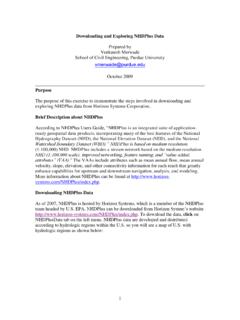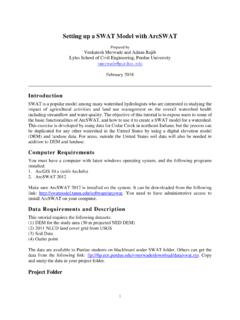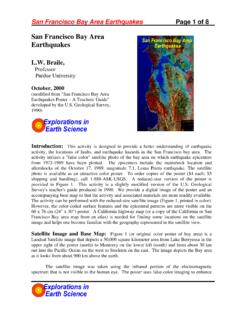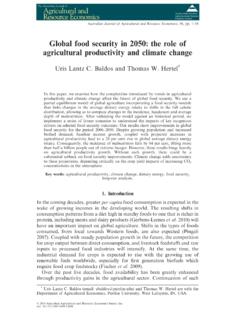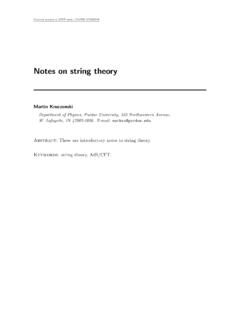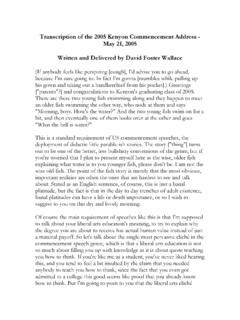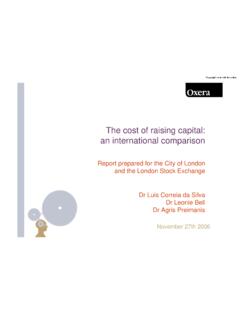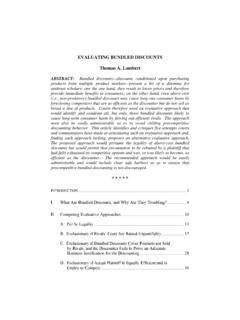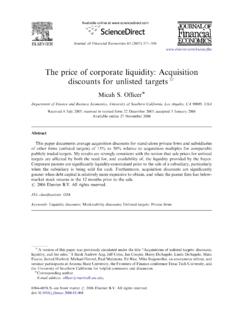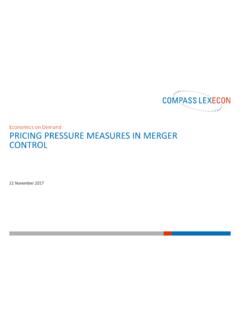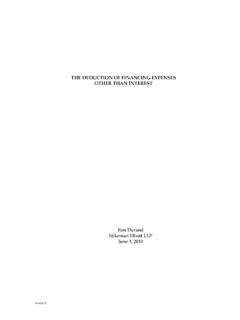Transcription of Competition in Posted Prices With Stochastic Discounts
1 Competition in Posted Prices with StochasticDiscounts David Gill John Thanassoulis April 23, 2015 AbstractWe study price Competition between firms over public list or Posted Prices when a fraction ofconsumers (termed bargainers ) can subsequently receive Discounts with some probability. Suchstochastic Discounts are a feature of markets in which some consumers bargain explicitly andof markets in which sellers use the marketing practice of couponing. Even though bargainersreceive reductions off the Posted Prices , the potential to discount dampens competitive pressurein the market, thus raising all Prices and increasing profits. Welfare falls because of the stochasticnature of the Discounts , which generates some misallocation of products to consumers.
2 We alsofind that Stochastic Discounts facilitate collusion by reducing the market share that can be gainedfrom a : Posted Prices ; list Prices ; collusion; bargaining; negotiation; haggling; discounting;coupons; price Classification: C78; D43; L13. This paper has been accepted for publication by theEconomic would like to thank the Editor and two anonymous referees for their detailed suggestions and earlier version of this paper was titled Competition in Posted Prices with Bargaining .xAssociate Professor, Department of Economics, University of Oxford. Email: of Financial Economics, Warwick Business School, University of Warwick; Associate Member,Oxford-Man Institute, University of Oxford; Associate Member, Nuffield College, University of Oxford.
3 IntroductionFirms often offer Discounts off public list or Posted Prices . For example, Busse et al. (2006)document the widespread use of price Discounts against fixed list Prices by car dealerships inCalifornia, while Goldberg (1996), Scott Morton et al. (2011) and the United Kingdom s Com-petition Commission (2000, Appendix ) document that Discounts in the private automobilemarket vary significantly across consumers, with some consumers receiving no discount at all offthe list price. A similar pattern holds for Discounts off estate agent (realtor) fees in the UnitedKingdom: the Office of Fair Trading (2004, Section ) found that almost 50% of house sell-ers using an estate agent had tried to negotiate fees, with 80% of those receiving a commentators often refer to evidence of bargaining off the list price in retail stores suchas jewellers, shoe shops, travel agents, furniture stores and electrical retailers (see, , SundayTimes, 2008, and Daily Telegraph, 2009).
4 In these examples, bargainers secure a reduction withsome probability that depends on the specifics of the interaction between the consumer and thegiven sales representative. Such Stochastic discounting is also a feature of the marketing strat-egy of offering discount coupons, which is widespread: Musalem et al. (2008) report that 286billion coupons were issued in the United States in 2006. Coupons or vouchers can be deliveredby direct mail, or by being placed in media outlets such as newspapers or the Internet; thesereductions, however, are discovered by the target consumers only with some this paper, we study the effect of discounting on price Competition between firms when afraction of consumers (termed bargainers ) can be strategically offered Discounts off list pricesthat they receive with some probability.
5 We find that even though bargainers often receivereductions off list Prices , Stochastic Discounts raise all Prices and cause a misallocation of goods toconsumers that lowers total welfare. Furthermore, when the firms interact repeatedly, discountsfacilitate collusion by the develop a tractable model of differentiated product price Competition followed by strategi-cally chosen Stochastic Discounts . First, the two firms simultaneously set list Prices that becomecommon knowledge. Price takers buy at list Prices . After the list Prices become known, eachfirm can also choose to offer a discount price that bargainers secure with some probability lessthan one. We call this probability the discount reliability.
6 Both categories of consumer areuniformly distributed along a Hotelling line, and so share a common view of product Section , we offer two specific interpretations of this model of Stochastic Discounts , whichmotivate the assumption that Discounts are received stochastically. We provide a summary here:1 Our leading interpretation is that the model captures explicit bargaining in a simple andtractable way. Price takers do not attempt to bargain, while bargainers approach bothfirms to ask for a better price than the one Posted . A bargainer receives a particular firm sreduced price offer with probability less than one. This assumption captures in a simpleway the fact that bargaining is uncertain: the psychological costs and tension of bargainingand the danger of frayed emotions lead to the possibility that negotiations between thesales representative and the consumer break down.
7 Our second interpretation is that the model captures the use of discount coupons. Bar-gainers regularly visit websites or newspapers in which firms offer discount coupons, while price takers do not. The assumption that discount price offers are received with probabil-ity less than one captures the fact that the bargainers do not always find a firm s coupon( , due to inattention, not visiting the website at the right time, not getting the rightissue of the newspaper). Stochastic Discounts affect the optimal pricing strategy in important ways. In particular,we demonstrate that list Prices and the Stochastic Discounts act as strategic complements. Thereason is that a firm s list price is relevant not only to price takers, but also to bargainers whofail to receive the firm s own discount price offer ( , who fail to discover the firm s discountcoupon, or who fail to close a deal with the firm s sales representative).
8 More specifically, thefirm s list price will compete with the rival firm s discount price for bargainers who fail to receivethe firm s own discount price offer but who do receive the rival s discount price. Thus, when afirm raises its list price, it becomes less of a competitive threat for such bargainers, which in turngives the rival firm an incentive to increase its discount price (the strategic complementarity).This softening of the Competition for bargainers leads to higher equilibrium discount Prices atthe discounting stage, and thus to higher profits from bargainers. Anticipating these benefitsencourages the firms to raise their list Prices , and so in equilibrium list Prices and discount priceoffers rise above the standard (Hotelling) moderating influence on Competition brought about by bargainers and Stochastic dis-counts not only increases Prices , but also raises profits and lowers both consumer surplus andwelfare.
9 Prices are a transfer from consumers to firms: hence higher Prices are welfare , Stochastic Discounts also lower welfare: a bargainer who happens to receive a discountprice offer from only one firm might be left with the choice between paying a high list pricefor the product she prefers and a lower discounted price for the less attractive product. Theconsumer can, in effect, be bribed to accept a less-ideal product. This generates some misallo-cation of products to consumers, which lowers the efficiency of the market. Furthermore, as the2proportion of bargainers in the market increases, all Prices rise at an increasing rate (both listprices and discount price offers), and welfare falls at an increasing also study the effect of Stochastic Discounts on the ability of the industry to sustaincollusive outcomes, thus extending our work to a dynamic setting.
10 To simplify the analysis,we consider the case where the products are perfect substitutes. However, we also extend ouranalysis by allowing any number of firmsN 2 to compete in the market. We find that discountsfacilitate collusion. The mechanism is that Discounts lower the profits available from deviatingon a collusive agreement. If a firm deviates only in the Discounts that it offers, it foregoes anyincrease in the market share of price takers. If, instead, a firm deviates by lowering its publiclyposted list price, then the rival firms can respond by discounting more aggressively. In eithercase the increase in market share available to firms from a deviation is reduced, thus allowingcollusion to be sustained at lower discount factors than would be possible without illustrate the insights of our analysis, consider the setting of the Harvard Business Schoolcase,The Toy Game(Brandenburger, 1995).
